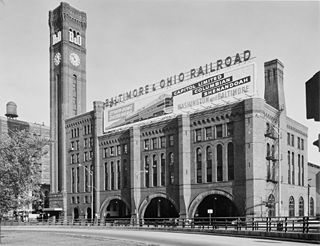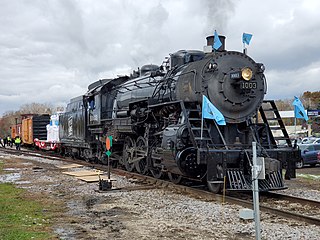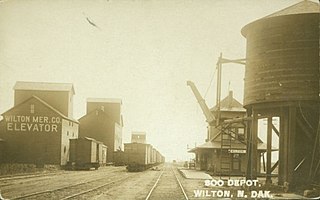
The Wisconsin Central Railway Company was created in 1897 when the Wisconsin Central Railroad (1871–99) was reorganized from bankruptcy. In 1954, it reverted to the name Wisconsin Central Railroad Company. The railroad was merged into the Soo Line Railroad in 1961.

The Soo Line Railroad is one of the primary United States railroad subsidiaries for the CPKC Railway, one of six U.S. Class I railroads, controlled through the Soo Line Corporation. Although it is named for the Minneapolis, St. Paul and Sault Ste. Marie Railroad (MStP&SSM), which was commonly known as the Soo Line after the phonetic spelling of Sault, it was formed in 1961 by the consolidation of that company with two other CPKC subsidiaries: The Duluth, South Shore and Atlantic Railway, and the Wisconsin Central Railway. It is also the successor to other Class I railroads, including the Minneapolis, Northfield and Southern Railway and the Chicago, Milwaukee, St. Paul and Pacific Railroad. On the other hand, a large amount of mileage was spun off in 1987 to Wisconsin Central Ltd., now part of the Canadian National Railway. The Soo Line Railroad and the Delaware and Hudson Railway, CPKC's other major subsidiary, presently do business as the Canadian Pacific Railway (CP). Most equipment has been repainted into the CP scheme, but the U.S. Surface Transportation Board groups all of the company's U.S. subsidiaries under the Soo Line name for reporting purposes. The Minneapolis headquarters are located in the Canadian Pacific Plaza building, having moved from the nearby Soo Line Building.

Grand Central Station was a passenger railroad terminal in downtown Chicago, Illinois, from 1890 to 1969. It was located at 201 West Harrison Street on a block bounded by Harrison, Wells and Polk Streets and the Chicago River in the southwestern portion of the Chicago Loop. Grand Central Station was designed by architect Solon Spencer Beman for the Wisconsin Central Railroad (WC), and was completed by the Chicago and Northern Pacific Railroad.

The Osceola and St. Croix Valley Railway is a heritage railroad in Osceola, Wisconsin owned and operated by the Minnesota Transportation Museum. It operates on former Minneapolis, St. Paul and Sault Ste. Marie Railroad trackage now owned by the Canadian National Railway.

The Chicago, St. Paul, Minneapolis and Omaha Railway or Omaha Road was a railroad in the U.S. states of Nebraska, Iowa, Minnesota, Wisconsin and South Dakota. It was incorporated in 1880 as a consolidation of the Chicago, St. Paul and Minneapolis Railway and the North Wisconsin Railway. The Chicago and North Western Railway (C&NW) gained control in 1882. The C&NW leased the Omaha Road in 1957 and merged the company into itself in 1972. Portions of the C. St. P. M. and O. are part of the Union Pacific Railroad network. This includes main lines from Wyeville, Wisconsin, to St. Paul, Minnesota, and St. Paul to Sioux City, Iowa.

Soo Line 2719 is a 4-6-2 "Pacific" type steam locomotive built by the American Locomotive Company (ALCO) for use on passenger trains operated by the Minneapolis, St. Paul and Sault Ste. Marie Railway. No. 2719 was used to haul the Soo Line's last steam-powered train, a June 21, 1959 round-trip excursion between Minneapolis, Minnesota and Ladysmith, Wisconsin. It was then displayed in Eau Claire, Wisconsin until 1996. It was restored and operated in excursion service from 1998 until 2013 when its boiler certificate expired. Today, the locomotive remains on static display in Duluth, Minnesota.
The Lake States Transportation Division (LSTD) was a wholly owned division of the Soo Line Railroad that existed from 1986 until 1987. The bankruptcy of the Chicago, Milwaukee, St. Paul and Pacific Railroad saw Soo Line acquire its routes to add trackage between Chicago and the Twin Cities in 1985. The Interstate Commerce Commission (ICC) mandated that Soo Line must divest of some lines in the interest of preserving competition.

Crosby station is a historic former train station in Crosby, Minnesota, United States. It was established in 1910. It was listed on the National Register of Historic Places in 1980 as the Crosby Railroad Depot for having local significance in the themes of commerce, industry, and transportation. The depot was nominated for being an essential conduit for the arrival of goods and people and the export of iron ore during central Crow Wing County's economic boom years.

Wisconsin Central Ltd. is a railroad subsidiary of Canadian National. At one time, its parent Wisconsin Central Transportation Corporation owned or operated railroads in the United States, Canada, the United Kingdom, New Zealand, and Australia.

The Soo Line L-1 class was a class of ten 2-8-2 (Mikado) steam locomotives built by the American Locomotive Company in 1913 for the Minneapolis, St. Paul and Sault Ste. Marie Railway.
Soo Line Depot may refer to the following train stations used by the Soo Line Railroad:

The Minneapolis, St. Paul and Sault Ste. Marie Railroad (MStP&SSM) was a Class I railroad subsidiary of the Canadian Pacific Railway in the Midwestern United States. Commonly known since its opening in 1884 as the Soo Line after the phonetic spelling of Sault, it was merged with several other major CP subsidiaries on January 1, 1961, to form the Soo Line Railroad.

Soo Line 2713 is an H-21 class 4-6-2 steam locomotive that was built for the Wisconsin Central Railway in May 1911. The WC had fallen under the control of the Minneapolis, St. Paul and Sault Ste. Marie Railway in 1909, and the locomotive fleets of both railroads were operated in a single pool.

Thief River Falls station is a historic train station in Thief River Falls, Minnesota. The station was built in 1913 to replace an earlier station and saw passenger traffic until 1967. It was listed on the National Register of Historic Places in 1995 as the Minneapolis, St. Paul and Sault Ste. Marie Railroad Depot and now serves as the Thief River Falls city hall.
Two former railroad stations are listed on the National Register of Historic Places as Minneapolis, St. Paul and Sault Ste. Marie Depot:

Wilton station in Wilton, North Dakota, USA, was built in 1900 by the Minneapolis, St. Paul and Sault Ste. Marie Railroad. Designed by William J. Keith, it was listed on the National Register of Historic Places in 1978 as the Minneapolis, St. Paul and Sault Sainte Marie Railroad Company Depot. It is also known as Soo Line Depot.

The Soo Line Rail Bridge (Blanchard Dam) is a steel deck truss bridge, built by the Minneapolis, St. Paul and Sault Ste. Marie Railway in 1909. The bridge crosses the Mississippi River northeast of Bowlus, Minnesota. The rail line was abandoned in 1993, and converted to a pedstrian/bicycle bridge as part of the Soo Line Recreation Trail in 2007. The bridge is directly downstream of the Blanchard Dam.

The Osceola Depot is a historic railroad station located at 114 Depot Rd. in Osceola, Wisconsin. The station was built in 1916 for the Minneapolis, St. Paul and Sault Ste. Marie Railroad. Later, the line would become a part of the Soo Line Railroad and eventually Canadian National. Today, the depot serves as a part of the Minnesota Transportation Museum as the starting point for a heritage railway.

Remer station in Remer, Minnesota, United States, is a depot built around 1910 by the Soo Line Railroad. It was listed on the National Register of Historic Places in 1980 as the Soo Line Depot.



















